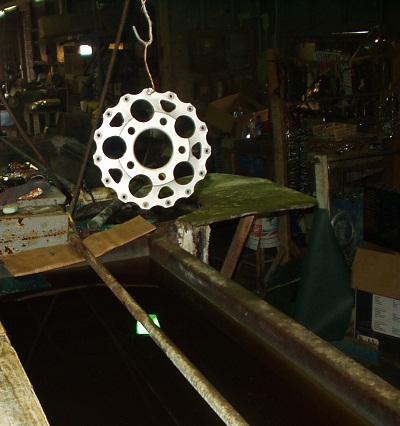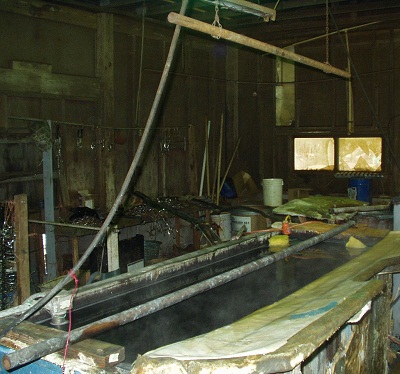Compliance Information
2012 Amendments to the NESHAP for Hard and Decorative Chromium Electroplating
On September 19, 2012, the US Environmental Protection Agency published a final review amending the National Emission Standards for Hazardous Air Pollutants: Hard and Decorative Chromium Electroplating and Chromium Anodizing Tanks (40 CFR Part 63, Subpart N). The rule changes satisfy Clean Air Act requirements that subject the NESHAP to review and revision every 8 years. The final rule revises emission limits for total chromium; adds housekeeping requirements to minimize fugitive emissions; and phases out the use of perfluorooctane sulfonic acid in fume suppressants. The rule amendments also modify testing, monitoring, recordkeeping and reporting requirements and revise provisions addressing emissions due to equipment malfunction.
The revised rule lowers chromium emission limits and surface tension limits for new and existing sources. For existing large hard chromium sources, the chromium emissions limit has been lowered from 0.015 milligrams per dry standard cubic meter to 0.011 mg/dscm. New large hard chrome plating sources will need to achieve a chromium emissions limit of 0.006 mg/dscm. Existing small hard chrome platers must meet a chromium emissions limit of 0.015 mg/dscm, while new small sources in this category must meet the 0.006 mg/dscm limit.
In the decorative chrome electroplating category, the chromium emissions limits have been lowered to 0.007 mg/dscm for existing sources and to 0.006 mg/dscm for new sources. The same limits will apply to existing and new chromium anodizing sources, respectively.
For electroplating or anodizing tanks in any category that utilize a chemical fume suppressant with a wetting agent, compliance with the emissions limit can be demonstrated by maintaining surface tension at or below 40 dynes per centimeter, if measured with a stalagmometer or 33 dynes/cm if measured with a tensiometer.
The compliance date for these revised emission limits (or surface tension limits) is September 19, 2014.
The 2012 rule amendments introduce a number of housekeeping requirements as a means to minimize fugitive chromium emissions. Required housekeeping procedures include:
storage of substances containing hexavalent chromium as a primary ingredient in a closed container in an enclosed area;
drip trays, containment or on-site treatment as controls for dripping of plating bath solution during dragout;
splash guards for electroplating and anodizing tanks;
prompt (i.e., within one hour) cleanup and containment of spills of hexavalent chromium substances;
routine cleaning and stabilization of storage and work surfaces, walkways, and other surfaces that could become contaminated with hexavalent chromium;
installation of barriers between plating or anodizing equipment and any buffing, grinding or polishing operations; and
proper storage, disposal, recovery or recycling of chromium-containing wastes.
These housekeeping procedures must be implemented within six months after publication of the rule, or by March 19, 2013.
The rule amendments also specified that perfluorooctane sulfonic acid (PFOS) fume suppressants can no longer be added to affected electroplating or anodizing tanks to meet the emissions limits for affected sources. Use of PFOS-based fume suppressants must be eliminated by September 21, 2015.
In addition, the 2012 rule amendments include changes to Startup, Shutdown and Malfunction requirements, electronic reporting requirements and certain testing and monitoring procedures. A provision to allow for an affirmative defense against civil penalties for violations of emissions standards caused by equipment malfunctions has been introduced.
If you need further guidance or assistance in complying with the Chromium Electroplating NESHAP, please contact us.
-
Previous Rule Updates
Chromium Electroplating NESHAP
The 1995 rules regulated emissions of chromium compounds from three categories of sources: hard chromium electroplating, decorative chromium electroplating and chromium anodizing, at both major and area sources.
Hard chrome sources were further categorized as either large - having a cumulative annual rectifier capacity at or above 60 million ampere-hours per year - or small. Tanks at large hard chrome plating facilities were required to meet an emissions limit of 0.015 milligrams total chromium per dry standard cubic meter of ventilation air, or alternatively, maintain the surface tension in affected tanks at or less than 45 dynes per centimeter if measured with a stalagmometer or 35 dynes/cm if measured using a tensiometer. Affected tanks at existing small hard chrome platers were required to meet an emissions limit of 0.030 milligrams per dry standard cubic meter; new facilities (constructed after December 16, 1993) had to meet the 0.015 mg/dscm limit. As with the large facility tanks, compliance could be demonstrated by meeting the (same) alternative limit on surface tension.
For decorative chromium electroplating facilities, the applicable emissions limit was 0.010 mg/dscm. Again, maintaining surface tension at or below 45 dynes/cm or 35 dynes/cm depending on method of measurement demonstrated compliance with the emissions limit.
Chromium anodizing sources (at which chromic acid is applied to aluminum to provide corrosion resistance) were required to meet the same emissions limit as decorative chrome platers.
The NESHAP was amended in 2004 to address changes in control technology and monitoring.
For additional guidance and assistance, please contact us.
-
Other MACT Emission Standards
Return to list of National Emission Standards for Hazardous Air Pollutants



